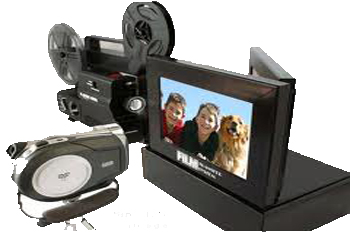
Film Conversion Equipment
Film Scanning and Film Transfer Equipment Types
The type of film scanning machine used for your 8mm, Super 8 or 16mm film conversion will have as much of an impact on the quality you receive as the resolution of the scan itself will. For example, if you wanted to digitize a photograph and tried doing it two different ways. You first put the photograph down on a table and took a picture of it using your smart phone or camera. Then you took the picture and scanned it using a flatbed scanner. If you compare the two side by side on your computer it will become really obvious that the flatbed scanner produced a digital image as good as the photograph. However, the picture you took with your phone or camera does not look close to the quality of the original photograph.
The same goes for scanning your 8mm, Super 8 or 16mm film. The real-time and frame by frame machines below are using a camcorder to take a picture of your film. The motion picture film scanner and Datacine machine are scanning the film. The results will be significantly different.
Film Conversion Equipment |
|
Real Time
|
|
Frame by Frame
|
|
Professional Film Scanners
|
|
Equally important as resolution is the type of film transfer. There are a few basic types of film transfer processes. More than 80% of the companies out there today use a real-time transfer. Any type of real-time film transfer will result in video that is 40-50% worse than the film’s current condition.
The film transfer processes above are the basics types and do not include any restoration by themselves. Restoration comes in many different capabilities from color and exposure correction, to grain elimination, to stabilization
Manchester Fun Facts: The most significant step in the industrial development of Manchester New Hampshire occurred in 1838 with the opening of the Amoskeag Manufacturing Company, which later became the world's largest textile manufacturing complex and spawned a huge textile industry in the city. A century of unparalleled productivity ensued, with Manchester serving as a prime focal point of America's industrial and technological revolution. But twentieth-century depression-era woes took their toll on the industry and when the Amoskeag Manufacturing Company finally closed down in 1936, Manchester’s economy was badly affected. For several years the city suffered a loss of jobs and population, but eventually rebounded and by the late twentieth century became one of the nation’s fastest-growing cities.
New Hampshire Fun Facts: Nevada is the seventh largest of the 50 states, but is one of the most sparsely populated. Carson City, in the western part of the state, is the capital. Gambling is legal in Nevada, and Las Vegas, the state’s largest city, is known internationally for its opulent casinos and as an entertainment destination. Nevada is also home to the Hoover Dam, which wasthe single largest public works project in the history of the United States, and Lake Mead, the largest reservoir in the country.








